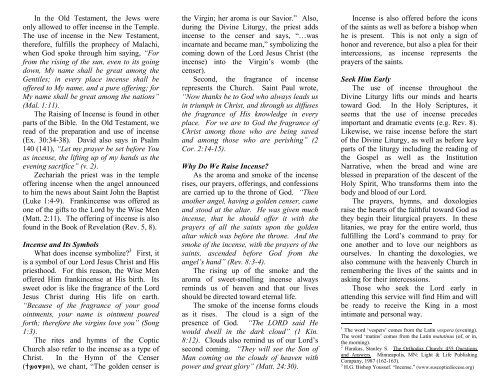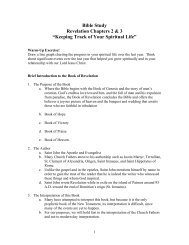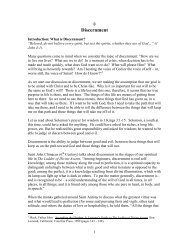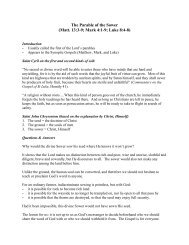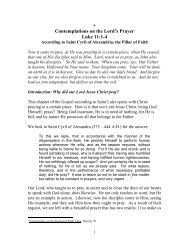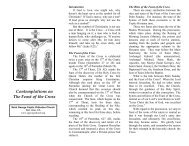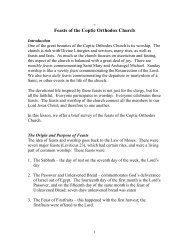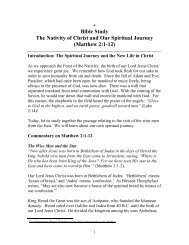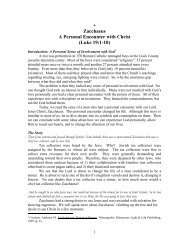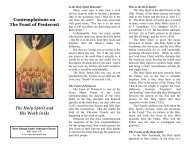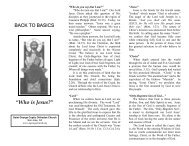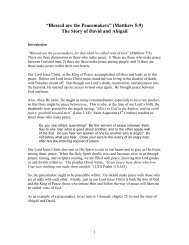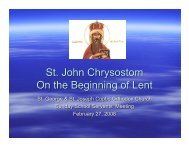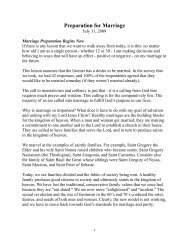The Raising of Incense - Saint George & Saint Joseph Coptic ...
The Raising of Incense - Saint George & Saint Joseph Coptic ...
The Raising of Incense - Saint George & Saint Joseph Coptic ...
You also want an ePaper? Increase the reach of your titles
YUMPU automatically turns print PDFs into web optimized ePapers that Google loves.
In the Old Testament, the Jews were<br />
only allowed to <strong>of</strong>fer incense in the Temple.<br />
<strong>The</strong> use <strong>of</strong> incense in the New Testament,<br />
therefore, fulfills the prophecy <strong>of</strong> Malachi,<br />
when God spoke through him saying, “For<br />
from the rising <strong>of</strong> the sun, even to its going<br />
down, My name shall be great among the<br />
Gentiles; in every place incense shall be<br />
<strong>of</strong>fered to My name, and a pure <strong>of</strong>fering; for<br />
My name shall be great among the nations”<br />
(Mal. 1:11).<br />
<strong>The</strong> <strong>Raising</strong> <strong>of</strong> <strong>Incense</strong> is found in other<br />
parts <strong>of</strong> the Bible. In the Old Testament, we<br />
read <strong>of</strong> the preparation and use <strong>of</strong> incense<br />
(Ex. 30:34-38). David also says in Psalm<br />
140 (141), “Let my prayer be set before You<br />
as incense, the lifting up <strong>of</strong> my hands as the<br />
evening sacrifice” (v. 2).<br />
Zechariah the priest was in the temple<br />
<strong>of</strong>fering incense when the angel announced<br />
to him the news about <strong>Saint</strong> John the Baptist<br />
(Luke 1:4-9). Frankincense was <strong>of</strong>fered as<br />
one <strong>of</strong> the gifts to the Lord by the Wise Men<br />
(Matt. 2:11). <strong>The</strong> <strong>of</strong>fering <strong>of</strong> incense is also<br />
found in the Book <strong>of</strong> Revelation (Rev. 5, 8).<br />
<strong>Incense</strong> and Its Symbols<br />
What does incense symbolize 3 First, it<br />
is a symbol <strong>of</strong> our Lord Jesus Christ and His<br />
priesthood. For this reason, the Wise Men<br />
<strong>of</strong>fered Him frankincense at His birth. Its<br />
sweet odor is like the fragrance <strong>of</strong> the Lord<br />
Jesus Christ during His life on earth.<br />
“Because <strong>of</strong> the fragrance <strong>of</strong> your good<br />
ointments, your name is ointment poured<br />
forth; therefore the virgins love you” (Song<br />
1:3).<br />
<strong>The</strong> rites and hymns <strong>of</strong> the <strong>Coptic</strong><br />
Church also refer to the incense as a type <strong>of</strong><br />
Christ. In the Hymn <strong>of</strong> the Censer<br />
(]sour/), we chant, “<strong>The</strong> golden censer is<br />
the Virgin; her aroma is our Savior.” Also,<br />
during the Divine Liturgy, the priest adds<br />
incense to the censer and says, “…was<br />
incarnate and became man,” symbolizing the<br />
coming down <strong>of</strong> the Lord Jesus Christ (the<br />
incense) into the Virgin’s womb (the<br />
censer).<br />
Second, the fragrance <strong>of</strong> incense<br />
represents the Church. <strong>Saint</strong> Paul wrote,<br />
“Now thanks be to God who always leads us<br />
in triumph in Christ, and through us diffuses<br />
the fragrance <strong>of</strong> His knowledge in every<br />
place. For we are to God the fragrance <strong>of</strong><br />
Christ among those who are being saved<br />
and among those who are perishing” (2<br />
Cor. 2:14-15).<br />
Why Do We Raise <strong>Incense</strong><br />
As the aroma and smoke <strong>of</strong> the incense<br />
rises, our prayers, <strong>of</strong>ferings, and confessions<br />
are carried up to the throne <strong>of</strong> God. “<strong>The</strong>n<br />
another angel, having a golden censer, came<br />
and stood at the altar. He was given much<br />
incense, that he should <strong>of</strong>fer it with the<br />
prayers <strong>of</strong> all the saints upon the golden<br />
altar which was before the throne. And the<br />
smoke <strong>of</strong> the incense, with the prayers <strong>of</strong> the<br />
saints, ascended before God from the<br />
angel’s hand” (Rev. 8:3-4).<br />
<strong>The</strong> rising up <strong>of</strong> the smoke and the<br />
aroma <strong>of</strong> sweet-smelling incense always<br />
reminds us <strong>of</strong> heaven and that our lives<br />
should be directed toward eternal life.<br />
<strong>The</strong> smoke <strong>of</strong> the incense forms clouds<br />
as it rises. <strong>The</strong> cloud is a sign <strong>of</strong> the<br />
presence <strong>of</strong> God. “<strong>The</strong> LORD said He<br />
would dwell in the dark cloud” (1 Kin.<br />
8:12). Clouds also remind us <strong>of</strong> our Lord’s<br />
second coming. “<strong>The</strong>y will see the Son <strong>of</strong><br />
Man coming on the clouds <strong>of</strong> heaven with<br />
power and great glory” (Matt. 24:30).<br />
<strong>Incense</strong> is also <strong>of</strong>fered before the icons<br />
<strong>of</strong> the saints as well as before a bishop when<br />
he is present. This is not only a sign <strong>of</strong><br />
honor and reverence, but also a plea for their<br />
intercessions, as incense represents the<br />
prayers <strong>of</strong> the saints.<br />
Seek Him Early<br />
<strong>The</strong> use <strong>of</strong> incense throughout the<br />
Divine Liturgy lifts our minds and hearts<br />
toward God. In the Holy Scriptures, it<br />
seems that the use <strong>of</strong> incense precedes<br />
important and dramatic events (e.g. Rev. 8).<br />
Likewise, we raise incense before the start<br />
<strong>of</strong> the Divine Liturgy, as well as before key<br />
parts <strong>of</strong> the liturgy including the reading <strong>of</strong><br />
the Gospel as well as the Institution<br />
Narrative, when the bread and wine are<br />
blessed in preparation <strong>of</strong> the descent <strong>of</strong> the<br />
Holy Spirit, Who transforms them into the<br />
body and blood <strong>of</strong> our Lord.<br />
<strong>The</strong> prayers, hymns, and doxologies<br />
raise the hearts <strong>of</strong> the faithful toward God as<br />
they begin their liturgical prayers. In these<br />
litanies, we pray for the entire world, thus<br />
fulfilling the Lord’s command to pray for<br />
one another and to love our neighbors as<br />
ourselves. In chanting the doxologies, we<br />
also commune with the heavenly Church in<br />
remembering the lives <strong>of</strong> the saints and in<br />
asking for their intercessions.<br />
Those who seek the Lord early in<br />
attending this service will find Him and will<br />
be ready to receive the King in a most<br />
intimate and personal way.<br />
1 <strong>The</strong> word ‘vespers’ comes from the Latin vespera (evening).<br />
<strong>The</strong> word ‘matins’ comes from the Latin matutinus (<strong>of</strong>, or in,<br />
the morning).<br />
2 Harakas, Stanley S. <strong>The</strong> Orthodox Church: 455 Questions<br />
and Answers. Minneapolis, MN: Light & Life Publishing<br />
Company, 1987 (162-163).<br />
3 H.G. Bishop Youssef. “<strong>Incense</strong>.” (www.suscopticdiocese.org)


